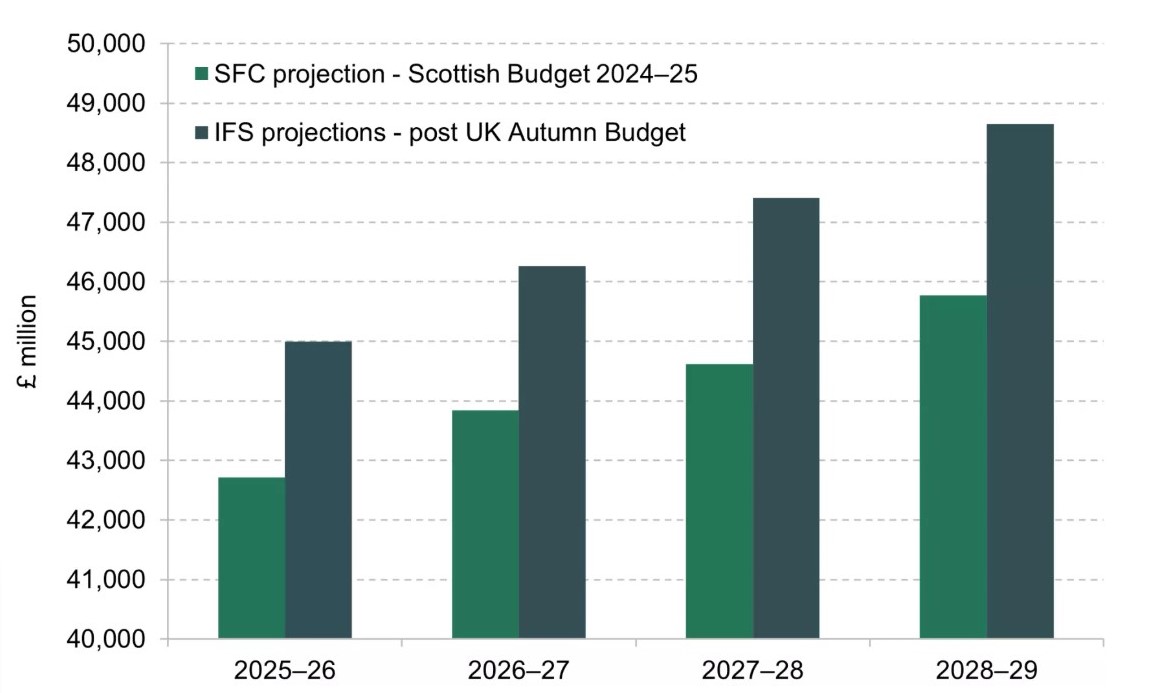The Scottish Government is in line for funding increases averaging 2.6% a year between 2025-26 and 2028-29 because of measures in last month's Autumn Budget and other in-year boosts, the Institute for Fiscal Studies has said.
But the think tank cautions that while the figures now point to a "transformed" financial picture compared with projections from the Scottish Fiscal Commission last December, "tough choices still loom" for ministers. It also notes that the 2.6% figure only equates to real-terms annual increases of 0.7%.
An IFS analysis of the Scottish Government's changed position says that chancellor Rachel Reeves's Autumn Budget was worth an extra £1.5bn this year alone because of Scotland's entitlements under the Barnett formula for allocating funding.
Scottish Government decisions made since its last budget have also ratcheted up the funding available for day-to-day spending. They include an increase in planned drawdown from ScotWind – one-off income from leasing the Scottish seabed for windfarms – from £200m to £424m; the planned drawdown of £162m in reserves, following underspends in 2023-24; and the cancellation of a planned £89m transfer from its resource to capital budget.
According to the IFS, the Scottish Government is now looking at resourcing available for public services in the region of £45bn for 2025-26, up from a figure of around £42.75bn in December last year.
However, the think tank said the frontloaded nature of the spending plans set out by Reeves on 30 October meant that Scotland – along with England – would see slower growth after next year.
Report authors Bee Boileau and David Phillips said that if Scotland's health and care spending increases in line with the IFS's 3.6%-a-year assumption for England, real-terms cuts of 2.3% in other areas of spending will still be required in 2025-26.
Research economist Boileau and associate director Phillips said that under such a model, cuts averaging 2.2% a year would be needed in non-health-and-care spending over the following three years.
They said that while the projections were only illustrative, they indicated the pressures the Scottish Government would be facing in the coming years and that some of the extra cash set to arrive with ministers may be best invested in reform.
"Carrying forward funding would ease trade-offs between services next year," they said. "But such funding can only be used once: it will only help the budgetary pressures facing the Scottish Government in later years if it is successfully utilised to help boost productivity, address the drivers of service demand, or boost economic performance and hence tax revenue.
"Even if successful, such efforts may take several years to bear fruit, meaning without further top-ups to UK spending plans and/or increases in Scottish taxes, some services will likely face cuts in future years."
 Resource funding available for public services, as expected in December 2023 and as estimated after the UK Autumn Budget. Source: IFS
Resource funding available for public services, as expected in December 2023 and as estimated after the UK Autumn Budget. Source: IFS
Boileau and Phillips said the Scottish Government should "plan realistically" and ditch its recent habit of "overpromising and then delaying or scaling back some initiatives" to free up funding for pay and NHS pressures.
"If it feels able to, it may be wise for the Scottish Government to ‘bank’ some of the increase in funding this year (by drawing down less from reserves and ScotWind proceeds, for example), to invest in skills, technology and other ways to boost public sector productivity or more generally to grow the economy," Boileau and Phillips said.
"And on the capital side of its budget, it could use its borrowing and reserves powers to smooth out the profile of capital spending over the next few years – money will likely be better spent with a bit more time to plan."
The Scottish Government is due to publish its 2025-26 budget on 4 December.